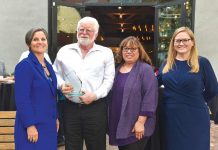In recognition of February being Black History Month, Gilroy was
honored Wednesday with the all-day visit of Terrence Roberts,
Ph.D., psychologist and Congressional Gold Medalist for his
contributions in the area of civil rights.
In recognition of February being Black History Month, Gilroy was honored Wednesday with the all-day visit of Terrence Roberts, Ph.D., psychologist and Congressional Gold Medalist for his contributions in the area of civil rights. He was one of the first nine African American students to voluntarily integrate the all-white Central High School in Little Rock, Ark.
Dr. Terrence Roberts was brought to Gilroy primarily by the sponsorship of Gavilan College, and also by the efforts of the Gilroy Library, the Gilroy United Methodist Church, and Gilroy High School. After spending the morning with students at Gavilan College, Dr. Roberts went on to speak to students in the afternoon at Gilroy High School. After a reception at the United Methodist Church where anyone could meet and talk with him about his personal experiences then and now, he planned an evening talk open to the public at the Gilroy Public Library on the subject of “Building Team Universe.”
Dr. Roberts speaks of how it was back in 1957 when, although the Supreme Court had ordered desegregation to begin, the Governor of Arkansas called out the National Guard to surround Central High with guns raised in order to prevent Terrence and eight other African American students from entering to attend classes. After weeks of unrest, President Dwight Eisenhower finally sent 1200 troops of the 101st Airborne Division to accomplish the task of enforcing court-ordered desegregation. While some of the nation cheered and others looked on in horror, the Little Rock Nine (as Roberts and his eight black classmates came to be known) withstood a daily barrage of insults, which included being beaten, having their skin clawed at and their clothing ripped, being spat upon, and bearing the contempt of white students as they shouted such angry words such as, “Run, nigger, run. Go home nigger … go back to Africa.” The harassment went so far that acid was thrown in the eyes of Melba Beals.
“I had to become a warrior,” she tells CNN, “I had to learn how to get from that door to the end of the hall without dying.” The determination of these 15-year-olds served as a catalyst for the integration of other previously segregated public schools in the United States.
Social activist Virginia Bogard, a local resident who grew up in Arkansas and a graduate of Little Rock High School herself, remembers what Arkansas was like. She tells me that as people reacted to desegregation by taking their children out of school, public schools actually began closing down. Pastors of various denominations who took a public stand in favor of desegregation instantly lost their jobs.
Those white families who could afford to do so kept their children permanently out of the public school system and enrolled them in private schools. Virginia describes to me the way some Little Rock schools came up with their own unique interpretation of obeying the Supreme Court desegregation ruling: they placed one black student in each classroom, seating him or her in a corner of the classroom carefully hidden behind a screen. In this way, they were technically complying with the letter of the law, while still managing to avoid the real integration intended by the law.
The Omnibus Appropriations Bill signed into law by President Clinton authorized Congress to present the highest civilian honor to each of the Little Rock Nine, in recognition of their courage as civil rights pioneers who have continued to work to celebrate, rather than negate, racial differences. President Clinton said of The Little Rock Nine, “It is fitting that we … recognize what these people did to make the walls of bigotry and prejudice fall in America. For when they marched up the steps to school — a simple act — they became foot soldiers for freedom, carrying America to higher ground.”
Upon award of the Congressional Medal of Honor, these words were entered into official historic record in regard to Terrence Roberts and his fellow students: “The Congress hereby finds the following: Jean Brown Trickey, Carlotta Walls LaNier, Melba Patillo Beals, Terrence Roberts, Gloria Ray Karlmark, Thelma Mothershed Wair, Ernest Green, Elizabeth Eckford, and Jefferson Thomas, hereafter in this section referred to as the “Little Rock Nine,” voluntarily subjected themselves to the bitter stinging pains of racial bigotry.
(B) The Little Rock Nine are civil rights pioneers whose selfless acts considerably advanced the civil rights debate in this country.
(C) The Little Rock Nine risked their lives to integrate Central High School in Little Rock, Arkansas, and subsequently the Nation.
(D) The Little Rock Nine sacrificed their innocence to protect the American principle that we are all “one Nation, under God, indivisible.”
(E) The Little Rock Nine have indelibly left their mark on the history of the Nation.
(F) The Little Rock Nine have continued to work toward equality for all Americans.”
In 1957, Hazel Bryan Massery was a white student who was captured on film with her face twisted in hate as she shrieked at Little Rock Nine student Elizabeth Eckford. In 1962, Hazel looked up Elizabeth’s phone number and called – to apologize. Forty years later, she is friends with Elizabeth, and they make joint public appearances together on behalf of racial healing and reconciliation. Hazel Massery is still the only white person in Little Rock to ever publicly apologize.
Kat Teraji’s column is published every Thursday in The Dispatch. You can reach her at ka****@*******nk.net.












